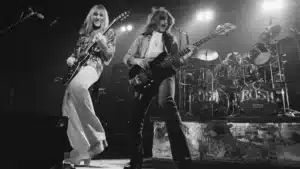Gentle Giant: Masters of Complexity and Innovation in Progressive Rock
Among the pantheon of progressive rock legends, Gentle Giant holds a unique and revered place. Unlike many of their peers who focused on extended instrumental solos or grandiose storytelling, Gentle Giant emphasized intellectual complexity, tight ensemble playing, and adventurous musical experimentation. Formed in 1970 and active until 1980, this British band remains a touchstone for musicians and fans who value compositional intricacy, contrapuntal textures, and genre-defying boldness.
While they never achieved the commercial heights of Yes, Genesis, or Pink Floyd, Gentle Giant developed a cult following and left behind a discography of remarkable depth and brilliance. Their music, challenging but rewarding, bridged classical music, medieval motifs, jazz, blues, and rock, often within the same track.
Origins and Formation
Gentle Giant was formed in Portsmouth, England, in 1970 by the Shulman brothers — Derek, Ray, and Phil. The three siblings had already gained musical experience in the late 1960s pop band Simon Dupree and the Big Sound, which had scored a hit with the psychedelic single “Kites.” Dissatisfied with the constraints of pop music, the Shulmans envisioned a project that would “expand the frontiers of contemporary popular music.”
To realize this vision, they recruited a group of highly skilled musicians: Kerry Minnear, a classically trained keyboardist from the Royal Academy of Music; Gary Green, a blues-influenced guitarist; and Martin Smith, a versatile drummer. The band’s name, “Gentle Giant,” was inspired by a fictional giant who was both gentle and powerful — a metaphor for their dual commitment to beauty and complexity.
A Band Apart: Musical Philosophy
From the beginning, Gentle Giant set out to defy convention. Their approach combined:
- Polyphony and counterpoint, inspired by Renaissance and Baroque music
- Odd time signatures and metric modulations
- Multinstrumentalism — band members often switched between instruments mid-performance
- Intricate vocal harmonies, often in canon or fugue form
- Minimalist production values, focusing on clarity over bombast
This cerebral yet deeply emotive style earned them admiration among critics and musicians, even as it often baffled mainstream audiences.
The Early Albums: Crafting a Unique Voice
Their self-titled debut album Gentle Giant (1970) introduced their layered sound with tracks like “Funny Ways” and “Giant,” combining medieval melodies with jazz and rock energy. It was an audacious debut, but merely a prelude to what followed.

The follow-up, Acquiring the Taste (1971), pushed boundaries further. With a manifesto inside the liner notes promising to “reject commercialism” and “expand music’s frontiers,” the album presented tracks like “Pantagruel’s Nativity” and “The House, the Street, the Room” — dense, shifting compositions that demanded full attention from listeners.
Classic Period: Creativity at Its Peak
Between 1972 and 1976, Gentle Giant released a series of albums that are now considered progressive rock classics:
- Three Friends (1972): A concept album tracing the lives of three childhood friends who grow apart. It was their first album recorded with drummer Malcolm Mortimore, replacing Smith. Musically, it explored heavier riffs and more accessible structures, foreshadowing future directions.
- Octopus (1972): Arguably their most beloved album, Octopus (named for its eight concise tracks) showcased their breadth — from the philosophical “Knots,” based on the writings of R. D. Laing, to the playful medieval flair of “Raconteur, Troubadour.” With John Weathers now on drums, the band reached new levels of rhythmic complexity.
- In a Glass House (1973): Often cited as their finest work, this album was originally released only in the U.K. due to Columbia’s belief it wouldn’t appeal to American audiences — a decision later regretted. The title track and “Way of Life” highlight their skill in combining rock aggression with classical formalism.
- The Power and the Glory (1974): A politically charged concept album exploring themes of corruption and authority. Tracks like “Proclamation” and “Cogs in Cogs” showcase their angular rhythms and dramatic vocal interplay.
- Free Hand (1975): Their most commercially successful album in the U.S., Free Hand found a delicate balance between accessibility and complexity. The title track, “Just the Same,” and “On Reflection” — the latter built around a vocal fugue — are quintessential Gentle Giant.
- Interview (1976): Framed as a radio interview, the album critiqued the music industry with characteristic wit and sophistication. Though not as acclaimed as its predecessors, it maintains the high level of musicianship.
Shifting Sounds and Decline
By 1977, the musical climate was changing. Punk and disco were on the rise, and progressive rock was being labeled as bloated or pretentious. Gentle Giant began to adapt their sound accordingly.
- The Missing Piece (1977) saw the band incorporating more pop and AOR elements. Tracks like “Two Weeks in Spain” and “Mountain Time” were more radio-friendly, but still retained intricate instrumentation.
- Giant for a Day! (1978) took this trend further, largely abandoning their prog roots in favor of streamlined rock. While not necessarily poor music, it lacked the complexity that longtime fans expected.
- Civilian (1980), their final album, was a polished but ultimately unremarkable effort that marked the band’s final attempt to break into mainstream markets.
By mid-1980, Gentle Giant quietly disbanded, closing a remarkable chapter in progressive rock history.
Legacy and Influence
Gentle Giant may not have sold millions of records, but their impact has been profound. Their music continues to inspire progressive and avant-garde musicians across the globe. Bands like Spock’s Beard, Echolyn, Haken, and The Dear Hunter cite them as a major influence. Dream Theater’s Jordan Rudess and Tool’s Danny Carey have spoken highly of the band’s compositional daring.
Reissues of their albums, remastered by Steven Wilson, have brought renewed attention to their work. In 2015, the band members released Three Piece Suite, a compilation of remixed early tracks. Occasional reunions — such as Gary Green and Malcolm Mortimore’s “Three Friends” live shows — keep their spirit alive.
Why Gentle Giant Still Matters
In an era of streaming and short attention spans, Gentle Giant’s music offers an antidote: layered, thoughtful, demanding, and deeply rewarding. Their refusal to conform to commercial norms and their commitment to craft over popularity remains a beacon for artists who value integrity.
They proved that rock music could be as intricate as Bach, as unpredictable as jazz, and as emotionally resonant as folk — sometimes all within the same track.
Conclusion
Gentle Giant were not just musicians — they were architects of sound, weaving dense tapestries that required and rewarded deep listening. Though their time as a band was relatively brief, their influence and artistry have stood the test of time. For fans of progressive rock and complex music in general, their discography remains a treasure trove of invention and inspiration.





